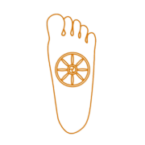Recently we hung a Buddhist flag in the meditation room in Shelburne. Surprisingly, not everyone was familiar with it! Though the Buddhist flag officially comes from the country of Sri Lanka, it is now a recognized international symbol of the buddhist faith. This is because it was adopted at a very important time for modern Buddhists. Up until that point, the European powers were working very hard to suppress local cultures in their asian colonies, and Christian missionaries were aggressively denouncing other religions. Without violence but with logic, truth, and by standing firm, the Buddhists won recognition as one of the world’s great religions at a time when they were relatively unknown.
Last Tuesday our Shelburne study group took some time to look at the famous Panadura Debates that led to the resurgence of Buddhism in Sri Lanka and the designing of the flag. If you aren’t familiar, here is some info from Wikipedia and a link to the text itself. A very fascinating piece of Buddhist history!
The Panadura Debate | PDF | Gautama Buddha | Nirvana (scribd.com)
Panadura Debate
All [the previous] debates culminated in the most notable, the “Panadura debate”, which was held two years after the Gampola debate in 1873. The cause for the debate arose when Rev. David de Silva delivered a sermon on the soul at the Wesleyan Chapel, Panadura on 12 June 1873.[5] Gunananda Thera delivered a sermon a week later criticizing the points raised by de Silva. The two parties signed an agreement on 24 July 1873 to hold another debate at Panadura. However, this was not the only cause of the debate.[3]
The Christians may have thought that the Buddhists were not educated and hence could be easily defeated in debate.[3] However, the Buddhist monks were familiar with Pali and Sanskrit texts like Nyaya Bindu written by Dignāga and Tarka sastra by Dharmakirti, which were written on the art of debating, and were not hesitant in accepting the challenge of debating in public.[3]
The debate was held on 24 and 26 August 1873 on a property owned by Jeramias Dias near the Rankot Vihara.[1][5] The ablest debaters were summoned on the side of the Christians. Gunananda Thera was the debater on the side of the Buddhists while de Silva and Catechist S.F. Sirimanna represented the Christian side. The debate revolved around topics ranging from the nature of God, the Soul, and resurrection, to the concept of Karma, Rebirth, Nirvana and the principle of Pratītyasamutpāda or dependent origination.[1]
Dr. K.D.G. Wimalaratna, Director of National Archives wrote:
“Rev. David de Silva, a fluent speaker in Pali and Sanskrit addressed the audience of around 6000-7000 – but only a very few understood him. In complete contrast was Mohottiwatte Gunananda Thera who used plain language to counter the arguments of his opponents.[5]“
Dr. Vijaya Samaraweera in his article “The Government and Religion: Problems and Policies c1832 to c1910”, stated:
“The Rev. Migettuwatte Gunananda proved himself to be a debater of a very higher order, mettlesome, witty and eloquent, if not especially erudite. The emotions generated by this debate and the impact of Migettuwatte Gunananda’s personality had lasting effects on the next generation of Buddhist activities. Migettuwatte Gunananda’s triumph at Panadura set the seal on a decade of quiet recovery of Buddhist confidence. In retrospect, the establishment of the ‘Society for the Propagation of Buddhism’ at Kotahena, and the Lankaprakara Press at Galle would seem to mark the first positive phase in this recovery.[5]“
At the end of the second day of the debate, the crowd chanted “sadhu, sadhu”,[1] displeasing the Christians. When the atmosphere became heated, Gunananda Thera raised his voice and ordered: “Everybody should be silent”. After that remark, the crowd was dispersed without making any further commotion.
Impact of the debate[edit]
The impact of the debate was phenomenal, both locally and internationally. Locally, it was the principal factor behind reviving the identity and pride of Sinhala Buddhists.[1]
Rev. S. Langden, who was present when Gunananda Thera spoke in the Panadura debate, remarked:
There is that in his manner as he rises to speak which puts one in mind of some orators at home. He showed a consciousness of power with the people. His voice is of great compass and he has a clear ring above it. His action is good and the long yellow robe thrown over one shoulder helps to make it impressive. His power of persuasion, shows him to be a born orator.[4]
Gunananda Thera continued work to revive Buddhism in the country and published many Buddhist periodicals, including Riviresa, Lakmini Kirana and Sathya Margaya.[4] He also served on the committee that designed the Buddhist flag in 1885.
